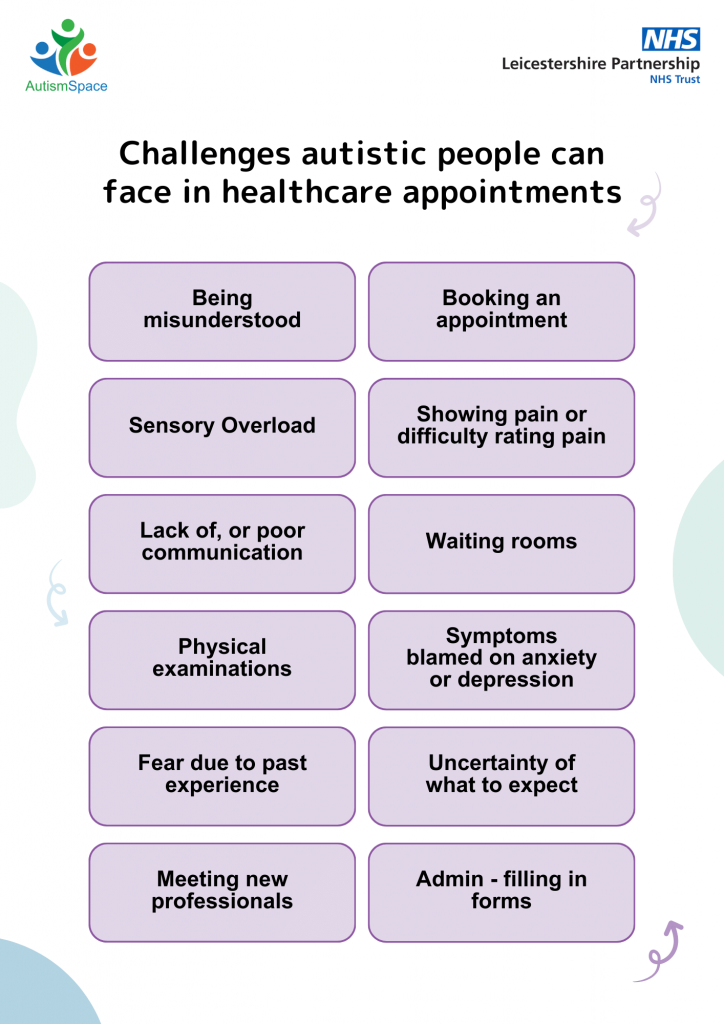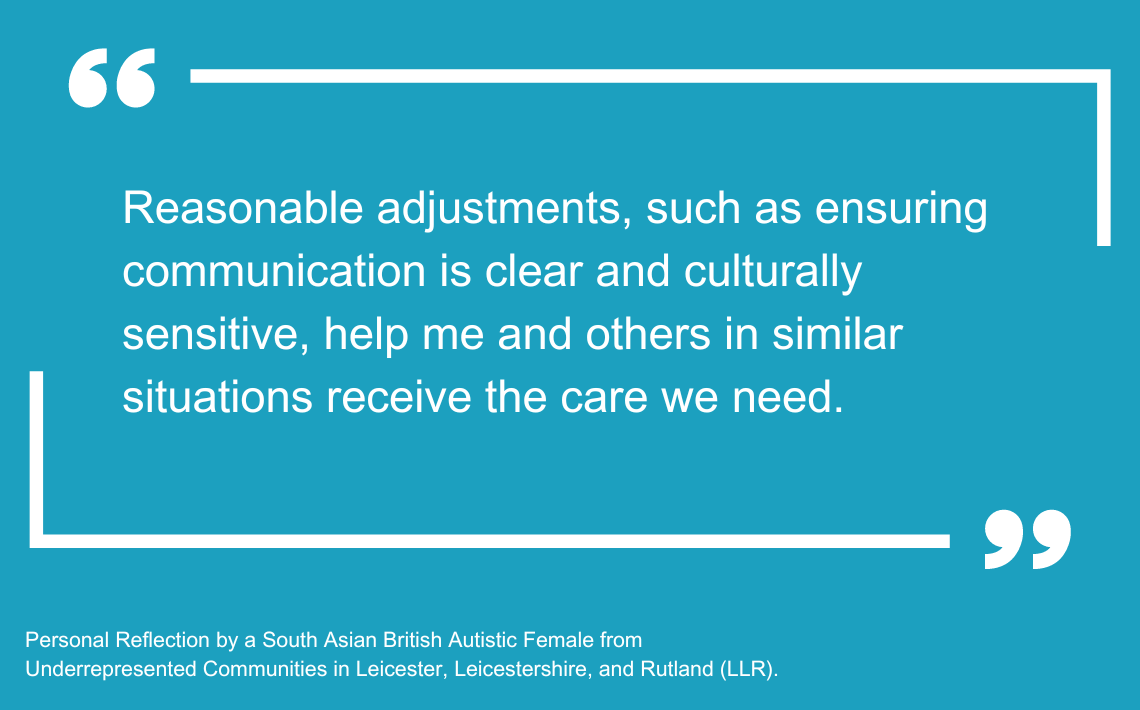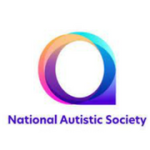Reasonable adjustments can be made to help autistic people feel as safe and calm as possible and to aid the best possible communication during health care appointments.
All adjustments need to be tailored to meet each autistic person’s individual needs. These adjustments could be requested by an autistic person or on behalf of an autistic person by a family member or carer.
Health care professionals are advised to check with any autistic person to find out what suitable reasonable adjustments they will need. Wherever possible, health care professionals should also support autistic people to have choices and autonomy in relation to their health care and any reasonable adjustments they may need.
A Health Passport is a useful way of recording and sharing what reasonable adjustments an autistic person needs.
Information about reasonable adjustments are listed after each section in ‘What can help’ lists. These can be used by both autistic people and health professionals.
Click here to view or download this graphic as an accessible pdf
Communication:
Many autistic people experience difficulties with communication. For example, it can be difficult to express emotions and pain. Masking may also interfere with how an autistic person communicates distress and symptoms. Autistic people are also likely to experience being misunderstood. Autistic people who are usually capable of communicating well in familiar situations, may find that unfamiliar environments and people can cause overwhelm and anxiety. This can reduce ability to process and express verbal information. Autistic people may also find it difficult to make sure the health care practitioner clearly understands the information they share and questions that they ask.
What can help:
- Using pre-prepared lists:
- What to ask
- What to tell
- Use clear and concise language
- Pause between each new piece of information
- Check each other’s understanding before moving to the next topic:
- If there is a lack of understanding, repeat
- Rephrase questions or information if needed
- Be clear about whether you are expressing an opinion or a fact
- Consider using any of the following communication strategies in addition to verbal communication:
- Writing notes
- Drawing pictures
- Pre-prepared visual aids – written, pictorial or objects
- Consider using a pain scale:
- Be aware that pain scales work for some autistic people but might not work for all
- There are different styles of pain scales that can be used.
- For example: a one to ten scale, or a scale showing a happy and sad faces (with variations in between)
- Modify pain scales to suit individual needs
Sensory environment:
Autistic people may also experience the environment differently from a non-autistic person. Noise can be particularly challenging, such as beeping from machines or a busy environment. Lighting can also make an autistic person distressed, such as fluorescent or flickering lights. Autistic people can also become distressed with certain smells from food or cleaning products. Temperature can be another sensory challenge, as this may be quite different from the person’s usual environmental temperature.
What can help:
- Noise cancelling headphones, ear plugs or ear defenders
- Quiet areas such as:
- single room accommodation
- separate waiting areas.
- Consider using dimmer switches, small lamps or sunglasses
- Consider adaptations to limit adverse reactions to smells, e.g.
- health care professionals can:
- avoid strong perfumes
- open windows or use fans to improve flow of fresh air
- autistic people can:
- carry something that smells pleasant or familiar to sniff and to distract from unavoidable unpleasant smells (e.g. a piece of cloth infused with essential oil)
- use a scarf to shield the nose from unpleasant smells
- health care professionals can:
- Being aware that people may prefer certain temperatures
- E.g. wearing a coat in warm weather
- E.g. disliking the temperature of medical equipment being used against the skin
Not knowing what to expect:
Changes can be distressing for autistic people, especially unexpected changes or disruptions to usual routines. For example, unfamiliar or unpredictable environments could make the person worry about how to get to the new environment and what to expect. Autistic people cope best with change when there is logic to it and have advance warning.
What can help:
- Visits or virtual tours of new or different environments
- Written and / or pictorial information detailing what to expect, including new people or new environments
- Consistency – e.g. familiar staff, familiar room
- Advance preparation, e.g:
- think about what questions you might be asked and have the appropriate information ready (e.g. information about medication)
- ensure you have any necessary equipment
- Whenever possible, keep to time
- Consider the possibility of time flexibility
- e.g. Could the appointment be shorter, longer, at a different date/time – depending on what works best to meet needs
- Ensure roles, rules and expectations are clear and consistent
- Do not make promises that you cannot keep
- Clarify:
- What has been decided and agreed
- What will happen next and when
- Ensure any information that needs to be shared is forwarded as soon as possible.
Digital Flag
The Reasonable Adjustment Digital Flag is a visible marker on a patient’s record which identifies the changes that need to be made by health and care services to make their services as accessible as possible.
The digital flag was developed to enable health and care workers to record, share and view details of reasonable adjustments across the NHS and wherever the person is treated.
By having reasonable adjustments recorded, it means that it would not be necessary to re-explain reasonable adjustments at each health appointment.
This process supports organisations in meeting their legal requirements under the Equality Act 2010.
Click this link to see more from the local LDA Collaborative on digital flags
Patient Passport
We know there are many potential challenges and barriers autistic people can face when visiting healthcare settings. So, it is important that anyone interacting with an autistic person during any health care appointment clearly understands that person’s individual difficulties and needs.
This will help the person to feel as safe and comfortable as possible – and ensure the clearest communication. Having all this in place gives the best chance of successful outcomes for the person’s health and wellbeing.
A Patient Passport is a document where a person’s reasonable adjustment needs can be recorded. It aims to be a quick and easy way for autistic people to advocate for themselves and for other people, such as health care staff or carers, to be sure of what they can do to help make the health care experience as stress free and successful as possible.
A Patient Passport ensures the following information can be recorded:
- Full name – and preferred name
- NHS number
- Current medication
- Allergies
- Communication needs
- E.g. Some people might need extra time to process new information, prefer verbal information to also be written down, or may find pictures helpful
- Information about how you experience, respond and communicate about pain
- E.g. Some people might have a particularly high or low pain threshold, or may have difficulties expressing pain using words
- Particular distress triggers
- E.g. Some people may have had difficult past experiences having a physical examination and may need certain reasonable adjustments and support with this
- Sensory sensitivities and / or needs
- E.g. some people may be particularly sensitive to the noise of medical machinery and find that noise cancelling headphones are helpful
- What sorts of things help a person to feel calm and comfortable
- E.g. some people might find it helpful to listen to music, play a game on their phone or have a conversation about their interests – as a helpful distraction in stressful situations
Top tips:
- Whenever possible the autistic person should decide what information goes into their Patient Passport
- Some autistic people will need support from a person who knows them well to help them think this through
- Use the ‘What Can Help’ sections above for ideas about what sort of reasonable adjustments might be best
- There is no set right or wrong way to make a Patient Passport. They will always need to be adapted to meet individual needs. For examples that can be used as templates – see the links below.
- Patient Passports should be checked regularly to make sure they are up to date
- Have both printed and digital copies of the Patient Passport
- Whenever possible Patient Passports should be shared with health professionals in advance. This gives time for reading, understanding and making the necessary reasonable adjustments.
- Patient Passports can be shared with anyone involved in a health care appointment.
- E.g. receptionists, dentists, health care assistants, transport assistants, ambulance crew, GP, nurse.
- In hospitals Patient Passports can be kept alongside medical notes at the end of the bed – so that all staff can see it
Patient passport links:
Click this link for a patient passport designed by the National Autistic Society.
A quote from our expert by experience:
Click this link to view her full personal account of reasonable adjustments in healthcare.






